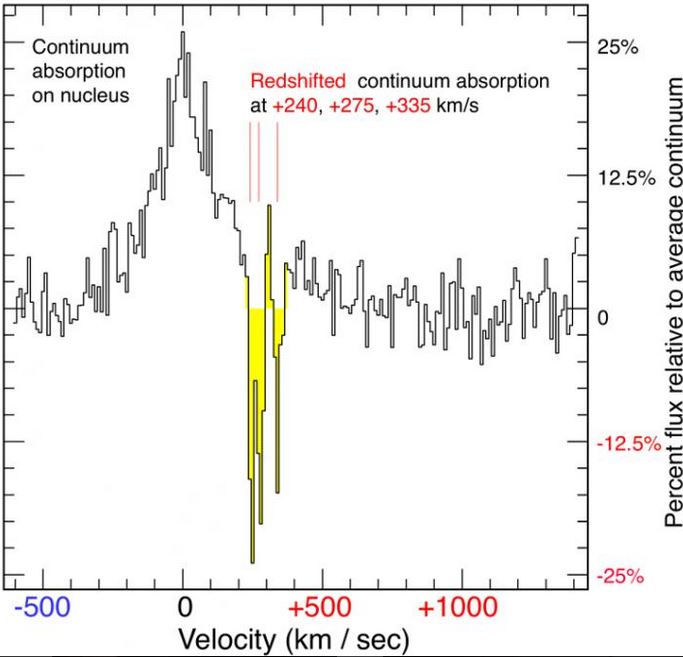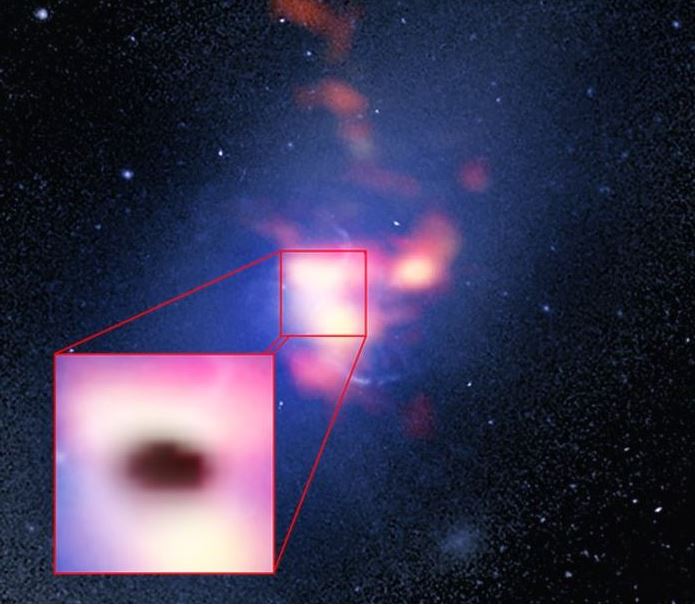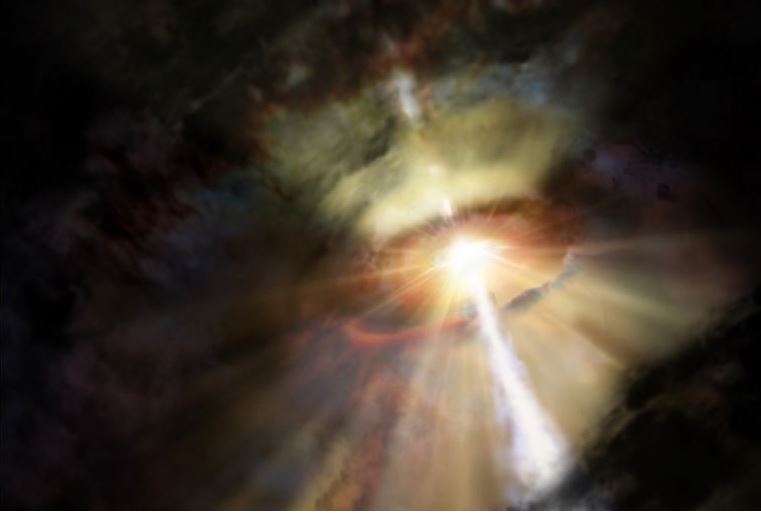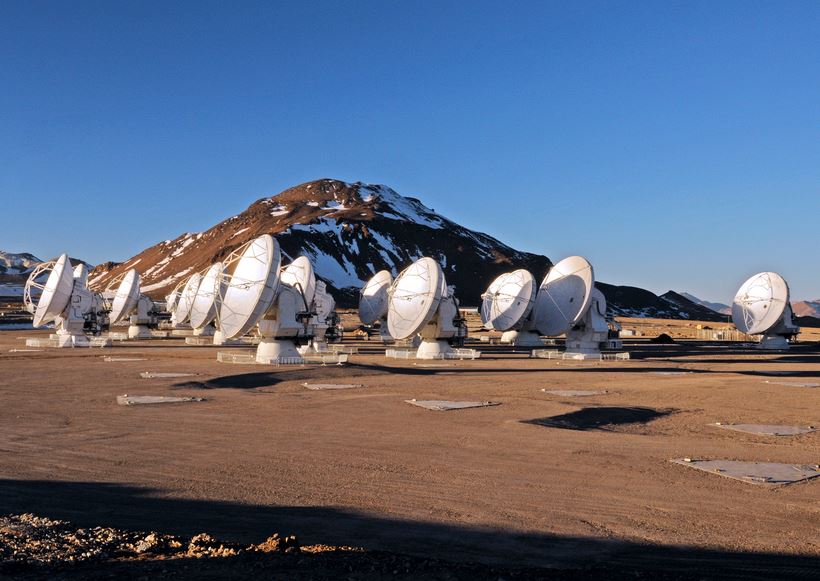Scientists have observed a supermassive black hole devouring giant, cold, intergalactic clouds, pulling them in with its colossal gravity at immense speed. An international team of astronomers says it is the first direct evidence that very cold, dense, billowy clouds can merge out of hot intergalactic gas and hurtle into the heart of a galaxy to feed its central *supermassive black hole.
* A supermassive black hole is the biggest type of black hole – typically in the order of hundreds of thousands to billions of solar masses (times the mass of our Sun). They are found in the centre of virtually every massive galaxy we know of.
 ‘Shadows’ cast by molecular clouds hurtling toward the supermassive black hole. Imprinting absorption lines on the continuum-subtracted spectrum from the region around the core of the galaxy. (Image: ast.cam.ac.uk)
‘Shadows’ cast by molecular clouds hurtling toward the supermassive black hole. Imprinting absorption lines on the continuum-subtracted spectrum from the region around the core of the galaxy. (Image: ast.cam.ac.uk)
Fuelling a black hole is a messy affair
The researchers explained in the journal Nature that their finding also reshapes scientists’ views on how supermassive black holes feed, in a process they call ‘accretion’. Fuelling a black hole is a great deal messier than scientists had once believed.
Astronomers had thought that supermassive black holes in the largest galaxies fed on a slow and steady supply of hot, ionized gas from the *galactic halo.
* The galactic halo primarily contains individual ancient stars and clusters of ancient stars (globular clusters). The halo also consists of ‘dark matter’, which is material we are unable to see but we know is there because its gravitational force can be measured. Our galaxy’s (Milky Way’s) halo is estimated to be more than 130,000 light years across.
Lead author, Grant Tremblay, an astronomer at Yale University, said:
“Although it has been a major theoretical prediction in recent years, this is one of the first unambiguous pieces of observational evidence for a chaotic, cold ‘rain’ feeding a supermassive black hole.”
“It’s exciting to think we might actually be observing this galaxy-spanning ‘rainstorm’ feeding a black hole whose mass is about 300 million times that of our Sun.”
 In this composite image of Abell 2597 brightest cluster galaxy, the background picture (blue) is from the NASA/ESA Hubble Space Telescope, while the foreground (red) is ALMA data showing the distribution of carbon monoxide gas in and around the galaxy. (Image: eso.org)
In this composite image of Abell 2597 brightest cluster galaxy, the background picture (blue) is from the NASA/ESA Hubble Space Telescope, while the foreground (red) is ALMA data showing the distribution of carbon monoxide gas in and around the galaxy. (Image: eso.org)
Dr. Tremblay, A NASA Einstein Fellow at Yale, and colleagues from the United States, Germany, the Netherlands, France, Canada, the United Kingdom and Mexico gathered and analysed data from ALMA (Atacama Large Millimeter/submillimeter Array) in northern Chile to map locations and movement of cold molecular gas in a knot of about fifty galaxies – the Abell 2597 Cluster – approximately 1,000,000,000 light-years from here.
Three gas clouds heading towards the black hole
They detected a trio of cold gas clouds hurtling through space at nearly one million km/h (621,371 mph) heading towards a supermassive black hole in a galaxy located right in the centre of the cluster.
Co-author Raymond Oonk, from Leiden University and ASTRON in the Netherlands, said:
“Thanks to the fantastic sensitivity and resolution of the new ALMA telescope, we can now for the first time observe that black holes can be fed by a clumpy stream of cold gas.”
The clouds are colossal – with enough material in each one to create over a millions sons. They measure many tens of light-years across.
Co-author C. Megan Urry, the Israel Munson Professor of Physics and Astronomy at Yale University, said:
“We can’t know whether all or only part of this ‘meal’ of cold gas will ultimately fall into the black hole, but the ALMA data spectacularly highlights the importance of this kind of cold accretion.”
 An artist’s depiction of the view from outside of a rapidly-accreting black hole. The bright light towards the centre represents the super-heating of gas as it is pulled into the black hole. Emanating from the centre is a jet of accelerated particles moving close to the speed of light. (Image: mit.edu. Credit: NRAO/AUI/NSF and Dana Berry/SkyWorks)
An artist’s depiction of the view from outside of a rapidly-accreting black hole. The bright light towards the centre represents the super-heating of gas as it is pulled into the black hole. Emanating from the centre is a jet of accelerated particles moving close to the speed of light. (Image: mit.edu. Credit: NRAO/AUI/NSF and Dana Berry/SkyWorks)
Co-author Louise Edwards, a researcher and astronomy lecturer at Yale, added:
“Since we know so little about the mechanics of how the AGN (active galactic nucleus) interacts with the rest of the galaxy, this is a real step forward.”
Co-author Michael McDonald, assistant professor of physics in MIT’s Kavli Institute for Astrophysics and Space Research, said:
“The simple model of black hole accretion consists of a black hole surrounded by a sphere of hot gas, and that gas accretes smoothly onto the black hole, and everything’s simple, mathematically.”
“But this is the most compelling evidence that this process is not smooth, simple, and clean, but actually quite chaotic and clumpy.”
In an Abstract that precedes the main article in the journal, the authors wrote:
“The observations show that these cold clouds also fuel black hole accretion, revealing ‘shadows’ cast by the molecular clouds as they move inward at about 300 kilometres per second towards the active supermassive black hole, which serves as a bright backlight.”
“Corroborating evidence from prior observations16 of warmer atomic gas at extremely high spatial resolution17, along with simple arguments based on geometry and probability, indicate that these clouds are within the innermost hundred parsecs of the black hole, and falling closer towards it.”
 The Atacama Large Millimeter/submillimeter Array (ALMA) is the largest astronomical project in existence. It is a single telescope of revolutionary design, composed of 66 high precision antennas located on the Chajnantor plateau, 5,000 meters (16,400 feet) altitude in northern Chile. (Image: eso.org)
The Atacama Large Millimeter/submillimeter Array (ALMA) is the largest astronomical project in existence. It is a single telescope of revolutionary design, composed of 66 high precision antennas located on the Chajnantor plateau, 5,000 meters (16,400 feet) altitude in northern Chile. (Image: eso.org)
Regarding the shadows, the European Southern Observatory wrote:
“The shadows are formed when the in-falling opaque gas clouds block out a portion of the bright background millimetre-wavelength light emitted by electrons spiraIling around magnetic fields very near the central supermassive black hole.”
The researchers say their next step is to use ALMA to search for more similar ‘rainstorms’ in other galaxies to see whether this type of cosmic weather is a common phenomenon in the Universe.
Article Reference: “Cold, clumpy accretion onto an active supermassive black hole,” Christopher, P. O’Dea, Stefi A. Baum, Alastair C. Edge, Stephen Hamer, Helen R. Russell, Alice C. Quillen, C. Megan Urry, Grant R. Tremblay, J. B. Raymond Oonk, Françoise Combes, Philippe Salomé, G. Mark Voit, Megan Donahue, Brian R. McNamara, Tracy E. Clarke, Roberto Galván-Madrid, Malcolm N. Bremer, Louise O. V. Edwards, Andrew C. Fabian, Timothy A. Davis, Michael A. McDonald, Yuan Li, Anaëlle Maury, Jeremy S. Sanders & Michael W. Wise. Nature. 9th June 2016. DOI: 10.1038/nature17969.
Video – Cold Intergalactic Rain
This European Southern Observatory video shows an artist’s depiction of condensing clouds of cold molecular gas around the Abell 2597 Brightest Cluster Galaxy.

